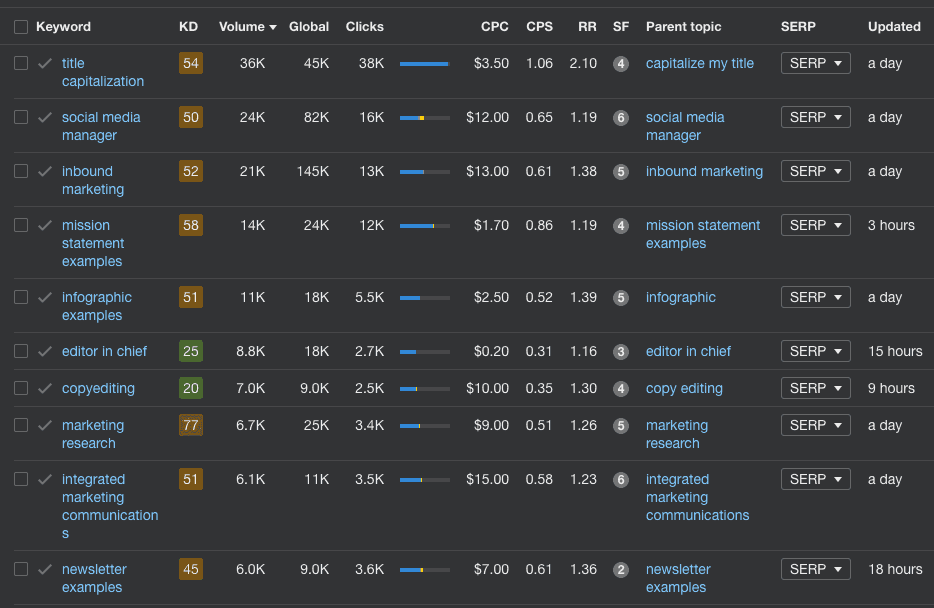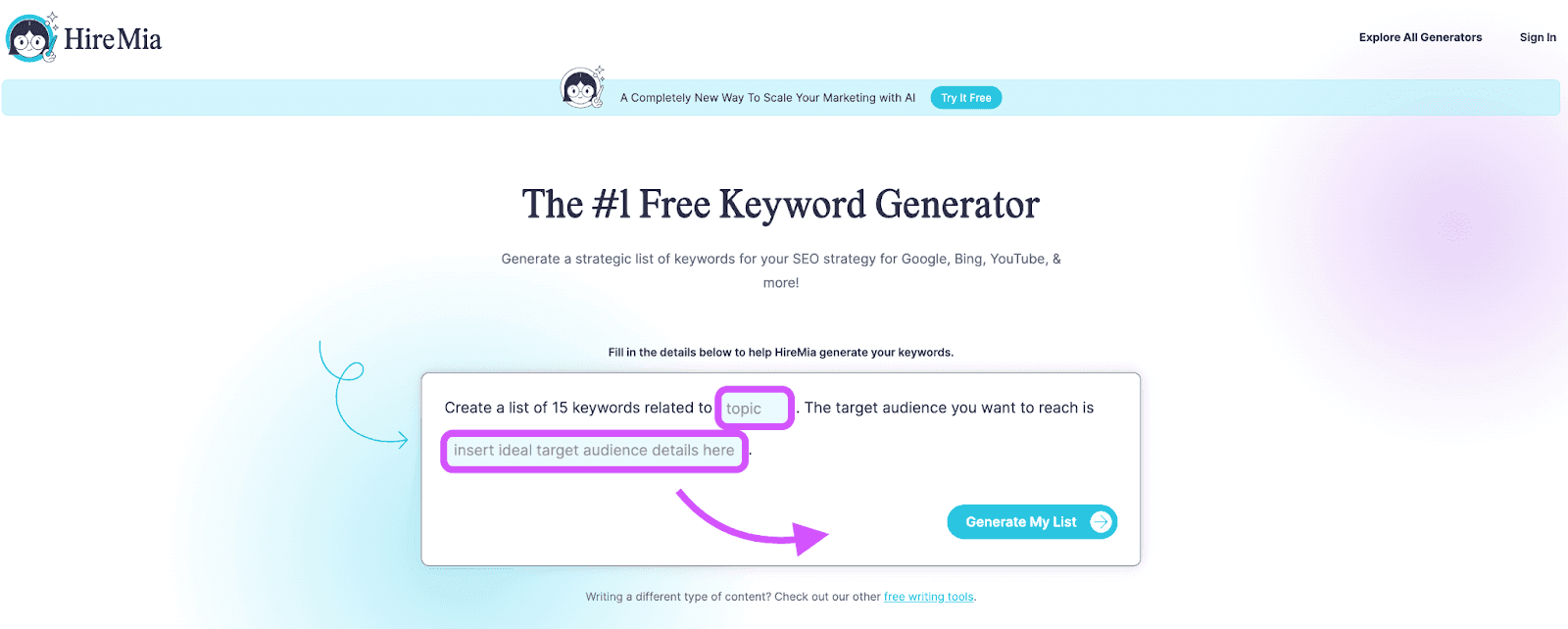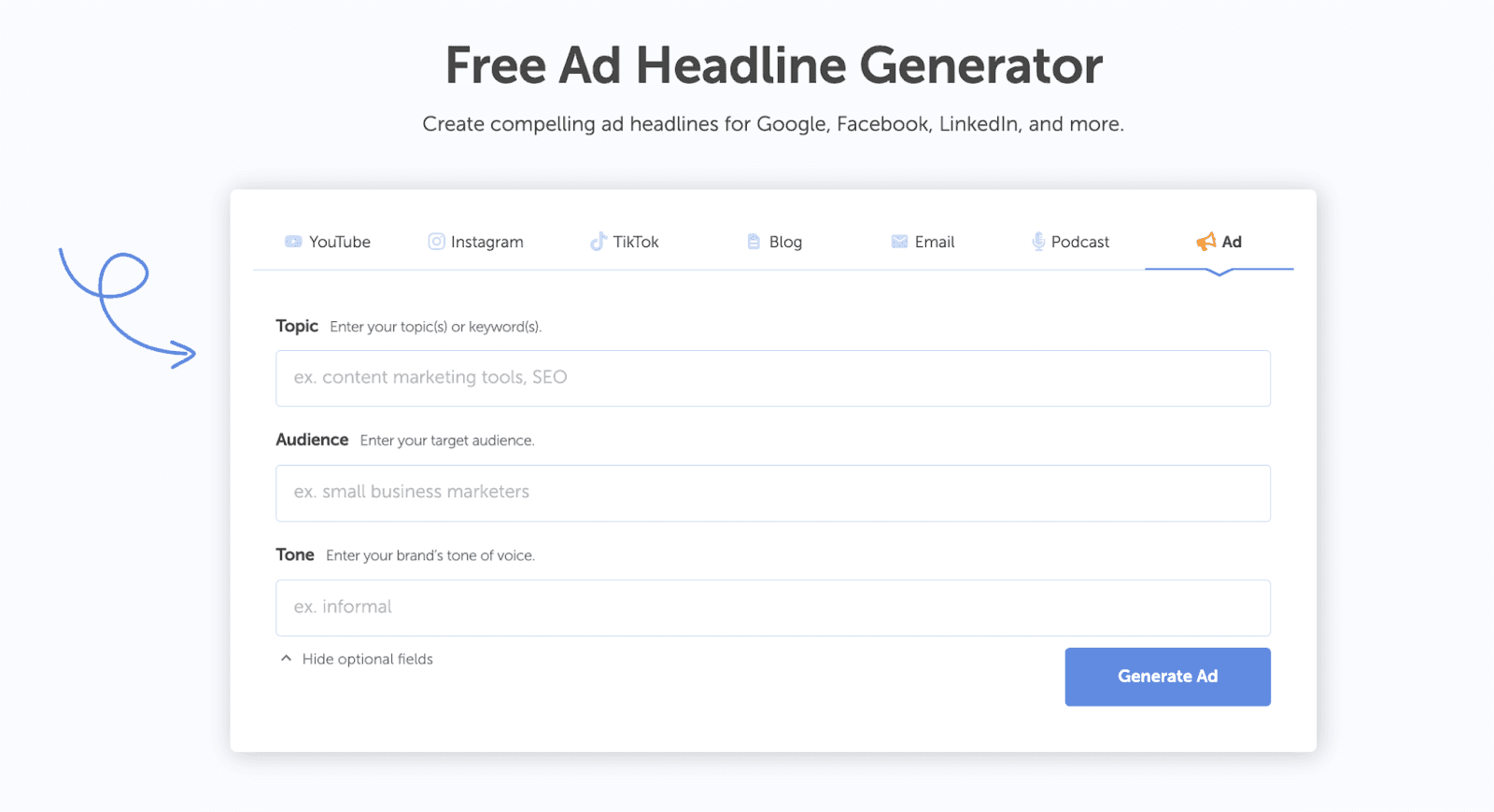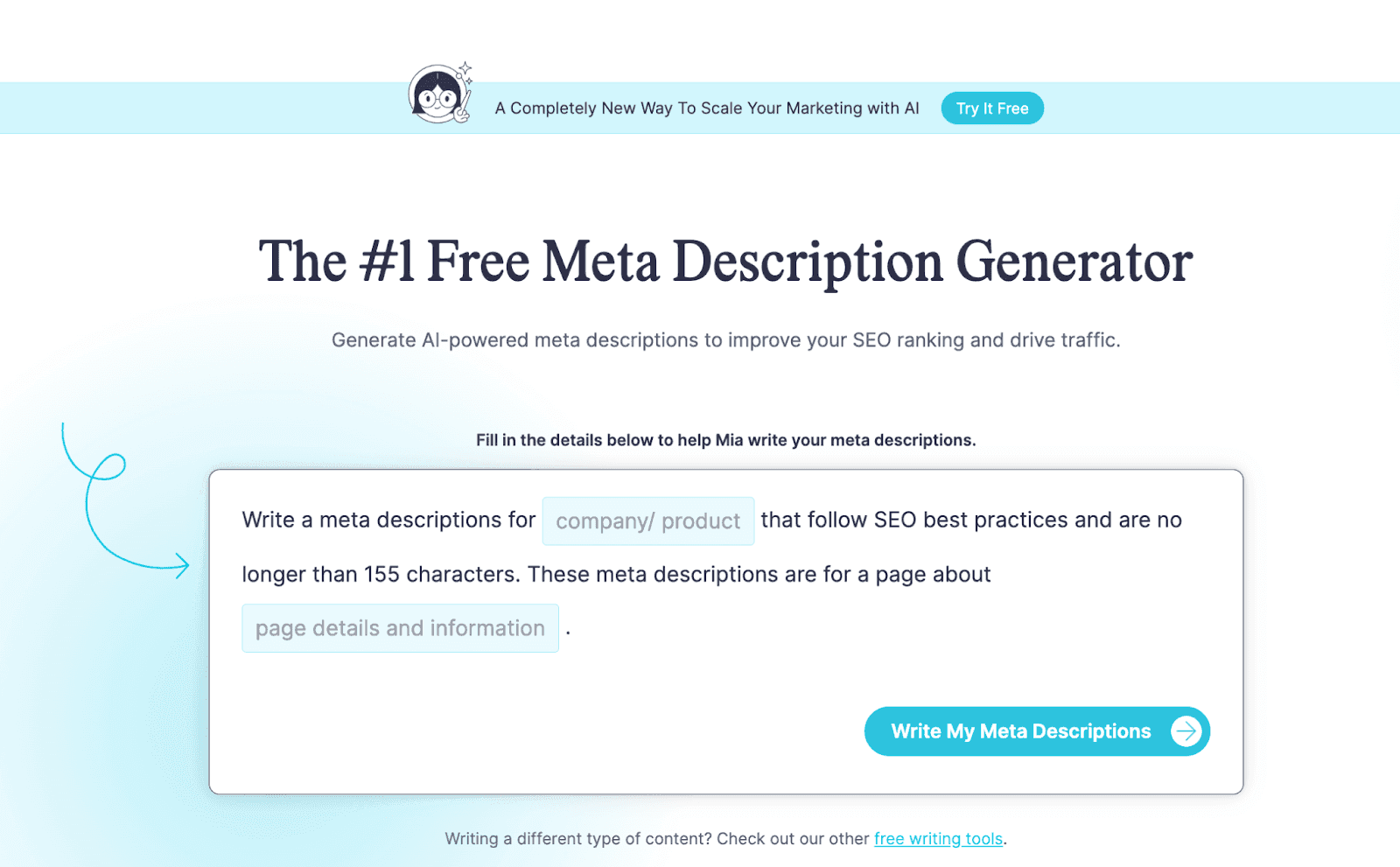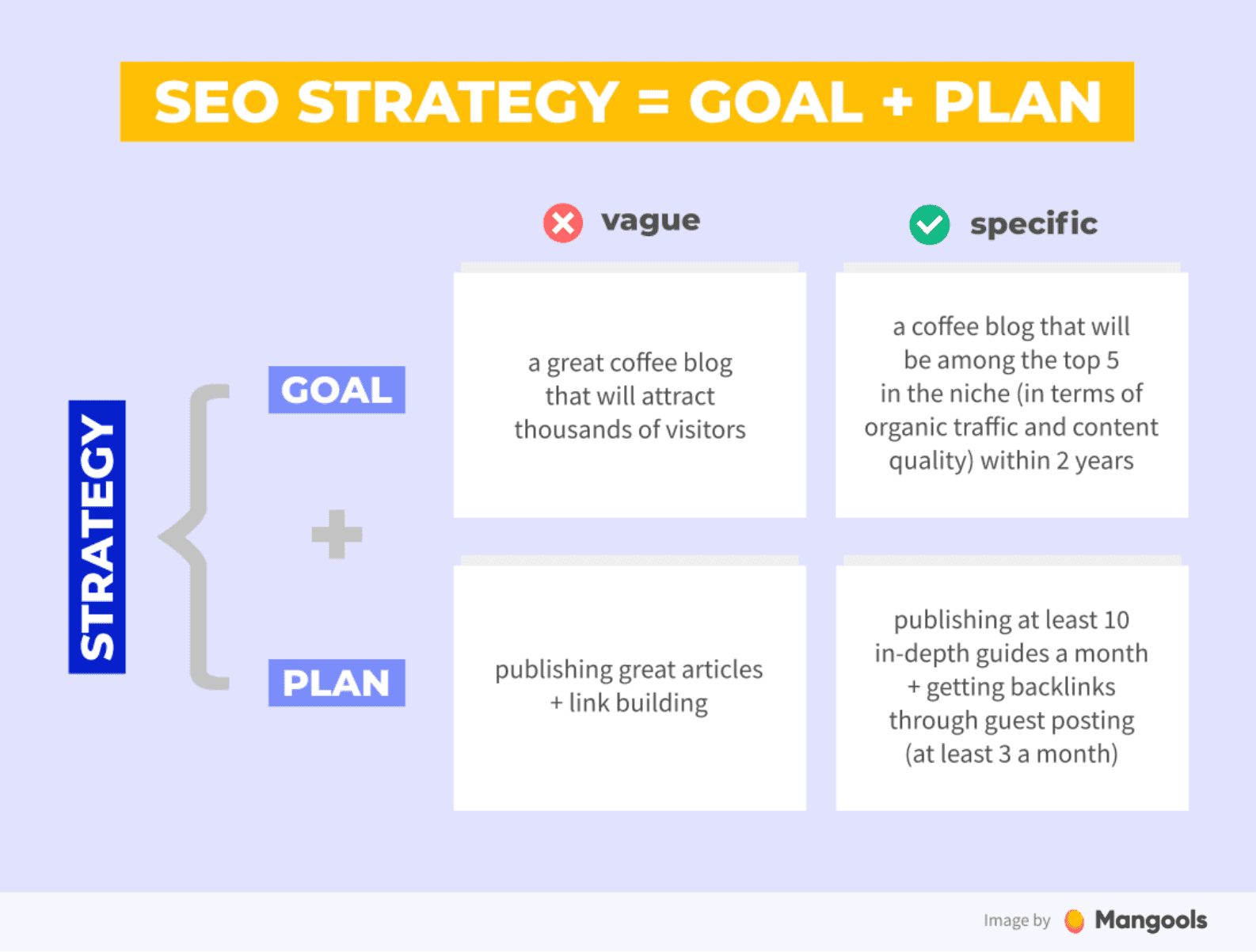SEO moves fast. It’s an ever-changing discipline where what worked six months ago, might be completely out of date. However, some fundamentals stay more or less the same.
When CoSchedule was first getting started, we knew we needed to attract the right kinds of customers. To pull those customers in, we also knew we needed to capture valuable search traffic.
After countless research and trial and error, we developed a successful strategy. In this guide, we’ll go over how you can apply our tactics to your SEO content strategy so you can drive success, too.
Step 1: Locate Your Nearest Keywords
To craft a robust SEO content strategy, begin by pinpointing the keywords that will drive your content to the forefront of search engine results. Some great tools you can use are Google Keyword Planner, SEMrush, and Ahrefs to expand your keyword arsenal.
Dive into competitor analysis, explore long-tail phrases, and incorporate location-based keywords if applicable. Understanding the language your audience uses lays the foundation for a content strategy that resonates and ranks.
Long-tail keywords are perfect for attracting targeted traffic to websites since they cater to specific niche interests and user search queries. Using long-tail keywords can result in higher conversion rates and more relevant content engagement.
Step 2: Learn Where You Stand
Understanding your current standing digital realm is crucial for effective SEO. The list of keywords you built using the keyword planner is your new content marketing checklist. These are the words that you want your site to “rank” well for on Google.
The next step is to load these goals into a tool that will help you track and monitor where your site ranks for each of these terms. For this, Ahrefs is a great place to start, but larger SEO tools like Moz are good options as well.
Ahrefs will tell you how your site ranks for each term. They will also monitor and report daily changes.
This is valuable information because it gives you a benchmark to work against. When you upload your initial list of terms, Ahrefs will give you an overall assessment of your site in comparison to your selected terms. Depending on how long you have been writing or working on SEO, your results may vary.
Step 3: Incorporate Goal Keywords Into Your Editorial Calendar Process
Once you have your keyword goals lined up, it is time to start incorporating them into your content marketing process.
At CoSchedule, our goal is to focus on one keyword phrase each week by adding a blog post with that keyword phrase to our editorial calendar.
Once the post is on the calendar, it will be written. If you aren’t managing an editorial calendar for your team, this is a great reason to do so – we strongly recommend it.
Now that you’ve worked through your keyword goals list the first time, be sure to refer back to Ahrefs regularly to help prioritize the keywords that you want (and need) to improve on.
Step 4: Use Basic Keyword Identification For All Of Your Posts
It is worth mentioning at this point that you should never be writing a blog post where a specific keyword isn’t identified.
On our team, we try as often as possible to identify the keyword immediately when scheduling a post. Each time we create a post, we either identify the keyword in the headline itself or note it in the comments field if we choose to write the headline later on.
Identify SEO Keywords Before Writing Your Content
This is a good practice to get your team into and will make a big impact on the quality of your posts. Not only will it add SEO value, but it will force your writing team to focus their writing on a well-selected and focused topic.
If you are having trouble identifying your keywords for one-off posts, there are a few places you can go. First, you can try out CoSchedule’s Free Keyword Generator. Simply type in the topic and target audience, and immediately generate 15 great keywords that are promised to rank.
You can also head back over to the Google Adwords Keyword Planning tool, but that might be overkill at this point. What I like to do is simply complete a basic Google search and take a look at the recommended search terms at the bottom of the page.
Related search terms on Google provide a wealth of keyword knowledge.
Step 5: Properly Optimize Your Content For Each Keyword
Once you have a keyword selected for your post, you will need a few tools to ensure that your content stays on point. The two tools that we use here at CoSchedule are Ahrefs and WordPress SEO from Yoast. If you are on a budget the Yoast plugin is free, and will get you 90% of the way to where you need to go.
Both of these plugins work similarly. With each, you start by declaring the keyword phrase used for the post. From there, the plugins will tell you how well your content ranks for those keywords. These plugins will evaluate your post based on several key factors:
Article Headline
It is best practice to include your exact keyword phrase in the headline of your post.
Page Title
The page title is the bit of text that will show up in your browser tab, or more importantly, at the top of your Google Search listing. You should include your keyword in full here.
Notice how nice that headline is? Your headline will also make a huge difference when it comes to SEO and SERP rankings. If you ever struggle to come up with unique headlines that will gain clicks, look no further. CoSchedule’s Free Headline Generators allow you to instantly generate YouTube and blog titles, Instagram and TikTok captions, email subject lines, podcast episode titles, and ad headlines.
Page URL
Your keyword should be included in the slug of your URL. WordPress makes this easy to customize as long as you do it before the post is published.
For example, the keyword for this blog post, AI marketing, is listed in the URL.
Content
Yoast will want to see that the keyword is mentioned within the content of your post. With this, the more you have the better. If you can include the keywords in various sub-headlines you will even get bonus points.
Meta Description
The meta description is the short description of your post that will show up on Google. You will want to use your keyword phrase in this copy.
Coming up with a meta description that is SEO and keyword-friendly can be difficult and time-consuming. With CoSchedule’s Meta Description Generator, you can easily generate the perfect meta description that describes your content well and will rank well on Google.
Make AI-powered meta descriptions to improve your SEO by using CoSchedule’s Meta Description Generator!
Simply type in your company or product name, and page details and information to generate the perfect meta description.
Topics vs. Strict Match
I want to point out that you need to be careful about the difference between the strict matching of keywords and topic-related searches. Yoast tends to lean too heavily on the strict match method, which is outdated by Google’s standards.
How To Make An SEO Content Strategy That Works
Sure, you can do some research and put together an SEO content strategy that might work. Instead, let us help you make a strategy that is bound to work and bring in the results you want.
Start With Your Goals
The best first step to any good strategy is taking the time to write out your goals and set priorities for each one. If your goal is to grow traffic, then you should align your strategy so it sets you up for success.
At CoSchedule, our SEO content goals look a little something like this:
- Grow traffic: Enabling our audience to find CoSchedule through search engines, guest posts, and republished content helps us grow our traffic.
- Increase subscribers: The content we publish on our blog, for the niche keywords specifically, always contains free downloadable content in exchange for an email address. In that way, we optimize our content not only to be found but to also convert readers into subscribers by providing valuable bonus content.
- Get more customers: The content we publish that targets the product keywords helps us turn readers into customers by showing the value CoSchedule provides as a marketing tool.
From the get-go, it just makes sense for us to prioritize SEO as a valuable component of our overall content strategy.
That said, certain keywords have more impact on those goals than others. For us, it makes sense to focus on both product and niche keywords. Here’s what to do:
- Prioritize each list of keywords according to importance for your business to help you reach your goals.
- Take a hard look at the average monthly searches, competition, and difficulty, and choose the ones that will be easiest for you to rank for now.
- Select the top 15 keywords from each list to have 30 total keywords to target in your first project.
Define Your Content Types
You could turn those keywords into a million different content formats, right? For each keyword, determine the best content type you’ll use to rank for that keyword.
At CoSchedule, we specifically think about the keywords first, then apply our knowledge of why our audience is searching for that term to the process. That helps us choose the right content type for each.
- Product: Think of e-commerce pages, landing pages, and feature pages. These aren’t necessarily best for blog posts because folks searching for these terms are likely ready to buy. Use the best content types to help you sell your product or service.
- Niche: Think more traditional content marketing like blog posts, landing pages, templates, and tools.
Want more readers for your blog? Discover tips in ‘How To Increase Blog Traffic‘!
Plan How You’ll Execute Your Project
Ask yourself, “Who’s doing what, and how will they do it?”
- Consider your resources: Take factors such as people, tools, and budget into consideration when planning to create the content.
- Establish a schedule: Aim to release two content pieces per week. This approach allows you to complete your initial project within approximately two months while spreading out the workload to avoid overwhelming your schedule.
- Break down tasks: Analyze each content piece, breaking it down into actionable tasks. Think of it as creating a workflow. If you have team members, collaborate with them to identify how their skills can contribute effectively.
- Utilize a good content calendar: Incorporate your content plan into your marketing calendar. Include the specific tasks within your workflow to ensure you meet every deadline successfully.
Create, Publish, And Share Your Optimized Content
Precisely in that order. Let’s go over how you can get your content out into the world.
Use the Keyword in Your Content
We’ve been over the importance of your keyword, but you may be unsure of where to use it.
Make sure your keyword is in your:
- Page title
- Meta description
- URL
- Headline
- Image name and alt (mainly for organization)
- At least a few times in the body copy (including in subheadlines)
Try our Free SEO Title Generator today!
Boost your content strategy with optimized descriptions! Try the SEO Description Generator to attract more clicks.
Share Your Content
By sharing, I mean optimizing your content for your readers to share it while distributing it yourself to reach more people.
- First, we optimize our content to help you share it with social media buttons and Click To Tweet.
- We also use the social queue in CoSchedule to help us share our content with our followers. Sharing our content more than once has helped us get 3,150% more traffic.
- Content promotion including email distribution is a huge driver of traffic for us to keep our audience coming back.
- When we reference other folks’ awesome content in our posts, we let them know through outreach marketing.
- We help our guest bloggers promote their content by providing helpful tips after publishing their posts.
All of these techniques help us gain the visibility our content needs to be shared, which grows our traffic and helps search engines understand its value.
Enhance your SEO workflow—read “Backlink Monitoring Tools: Working Mechanisms and Top Tools” now!


